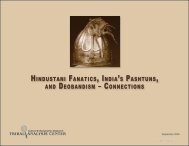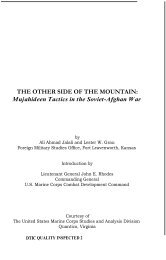The Baluch <strong>and</strong> <strong>the</strong> Brahui - <strong>and</strong> <strong>the</strong>ir RebellionsThe Baluch(Baloch, Balooch, Beluch, Biluch)<strong>Tribal</strong> StructureThe Baluch ethnic group is comprised of approximately 15-25 independent units, more akin to confederations than tribes. Baluch tribalhierarchies are somewhat loosely defined, being based more on alliance <strong>and</strong> location than tribal identity. Largely independent from one ano<strong>the</strong>r, eachtribe recognizes a clear internal hierarchical structure, a characteristic that differentiates <strong>the</strong> Baluch from <strong>the</strong> more egalitarian neighboring Pashtuntribes. This hierarchic structure greatly impacts Baluch tribal unity <strong>and</strong> interaction with o<strong>the</strong>r groups. The Baluch have traditionally been moreresponsive to both internal <strong>and</strong> external authority <strong>and</strong> more willing to incorporate outsiders than Pashtun tribes.The Baluch are broadly divided into eastern <strong>and</strong> western linguistic groupings with <strong>the</strong> Brahui ethnic group falling between. The western Baluchtribes, referred to as Mekrani Baluch after <strong>the</strong> Mekran region, is <strong>the</strong> smaller of <strong>the</strong> two <strong>and</strong> includes those tribes located in Mekran Division, KharanDistrict of Kalat Division, Chagai District of Quetta Division in Baluchistan, <strong>and</strong> those living in sou<strong>the</strong>astern Iran <strong>and</strong> southwestern Afghanistan. Mostof <strong>the</strong> tribes of <strong>the</strong> eastern grouping, referred to as Sulaimani Baluch after <strong>the</strong> Sulaiman Range, are located primarily in Sibi Division, Baluchistan.O<strong>the</strong>rs live in Nasirabad Division, Baluchistan, <strong>and</strong> large numbers live outside Baluchistan in Punjab <strong>and</strong> Sindh Provinces. A few also live in <strong>the</strong>North-West Frontier Province. The western or plains Baluch have historically been seen as more peaceful than <strong>the</strong> eastern or hill Baluch.The British who dealt with <strong>the</strong> Baluch from <strong>the</strong> mid-1800s to mid-1900s saw both <strong>the</strong> western <strong>and</strong> eastern Baluch as easier to manage than <strong>the</strong>Pashtun tribes to <strong>the</strong> north <strong>and</strong> nor<strong>the</strong>ast. Stereotypes of <strong>the</strong> independent, egalitarian Pashtun with a strong sense of Pashtun identity contrast withthose of <strong>the</strong> less independent, more hierarchical Baluch who mix more freely with o<strong>the</strong>r tribes. The stereotypes still exist, even among <strong>the</strong> Baluch <strong>and</strong>Pashtuns <strong>the</strong>mselves. Pashtun tribes usually claim descent from a common ancestor <strong>and</strong> recognize a familial-like bond within <strong>the</strong>ir division, clan, <strong>and</strong>tribe. They also recognize a very strict common set of characteristics that make one a Pashtun, including speaking Pashtu <strong>and</strong> following <strong>the</strong> Pashtuncode or Pashtunwali. The Baluch on <strong>the</strong> o<strong>the</strong>r h<strong>and</strong> define <strong>the</strong>ir tribe according to more political <strong>and</strong> geographic criteria: loyalty to an authority <strong>and</strong>common location. Anyone choosing to live under <strong>the</strong> authority of <strong>the</strong> tribal chief can be considered a part of <strong>the</strong> tribe. An outsider wishing to join aBaluch tribe or section first moves into a Baluch tribe’s area, shares in <strong>the</strong> tribe’s good <strong>and</strong> ill fortune, is eventually able to obtain tribal l<strong>and</strong>, <strong>and</strong> isfully admitted upon marrying a woman from <strong>the</strong> tribe.The tendency of Baluch tribes to take on outside groups or members, <strong>and</strong> likewise for groups or members to leave one tribe for ano<strong>the</strong>r, makesestablishing a basis for a tribal hierarchy difficult. One often encounters <strong>the</strong> same sub-element split between two or more tribes. To fur<strong>the</strong>r complicatematters, elements sometimes change <strong>the</strong>ir names or take on <strong>the</strong> name of <strong>the</strong>ir host, even in <strong>the</strong> case where <strong>the</strong>y are not ethnically Baluch. In manyparts of Baluchistan, it is popular to be considered a Baluch, so non-Baluch will sometimes take on Baluch tribal names, <strong>and</strong> after many years, maybecome considered as such. For example, Gichkis, Khetrans, <strong>and</strong> Nausherwanis are considered to be of non-Baluch origin (Khetrans do not evenspeak Baluchi), <strong>and</strong> yet multiple sources list <strong>the</strong>m as Baluch in tribal hierarchies.<strong>Tribal</strong> <strong>Analysis</strong> <strong>Center</strong>, 6610-M Mooretown Road, Box 159. Williamsburg, VA, 23188
The Baluch <strong>and</strong> <strong>the</strong> Brahui - <strong>and</strong> <strong>the</strong>ir RebellionsThe structure within each Baluch tribe follows a more or less common pattern: 23I. Tuman/Toman (Tribe): The Baluch are divided into tumans led by a tum<strong>and</strong>ar/tom<strong>and</strong>ar (chief). 24 The term tuman also refers to a Baluch village.A. Para/Phara (Clan): Tumans are divided into paras led by a mukadum/mukadam (headman or chief).1. Pali/Phalli (Sept or Division): Paras are divided into palis led by aheadman, sometimes called a wadera.a. Family: Palis are sometimes fur<strong>the</strong>r divided into family groupsled by <strong>the</strong> head of <strong>the</strong> family, sometimes called a motabar.A grouping called a sub-tuman occurs in some cases between tuman <strong>and</strong> para <strong>and</strong> is a large clan or sub-tribe, having its own significant sectionsakin to clans. Examples of <strong>the</strong>se are <strong>the</strong> Haddiani clan of <strong>the</strong> Leghari tribe, <strong>the</strong> Durkani <strong>and</strong> Lashari clans of <strong>the</strong> Gurchani tribe, <strong>the</strong> Ghulmani clanof <strong>the</strong> Buzdar tribe, <strong>the</strong> Shambani clan of <strong>the</strong> Bugti tribe, <strong>and</strong> <strong>the</strong> Mazarani clan of <strong>the</strong> Marri tribe.According to legend, when <strong>the</strong> Baluch first arrived in Baluchistan, <strong>the</strong>y were united under one headman, one Jalal Khan, but soon split ei<strong>the</strong>ralong ancestral lines or based on which headman <strong>the</strong>y chose to follow as <strong>the</strong>y spread north <strong>and</strong> east across Baluchistan. Some sources indicate <strong>the</strong>Baluch are essentially made up of three or five main tribal groupings, though <strong>the</strong>se vary according to <strong>the</strong> source. Some list <strong>the</strong> Narui, Rind, <strong>and</strong> Magzi,some <strong>the</strong> Rind, Magzi, <strong>and</strong> Lashari, <strong>and</strong> some <strong>the</strong> Rind, Hot, Lashari, Kaheri, <strong>and</strong> Jatoi. 25 In addition to <strong>the</strong>se, <strong>the</strong>re were several o<strong>the</strong>r unaffiliatedBaluch tribes. These divisions seem to serve little purpose today. Though a Baluch tribe may hearken back to <strong>the</strong>ir Rind or Lashari origins, <strong>the</strong>y areindependent of <strong>the</strong>se tribes.23. The Marri tribe does not use <strong>the</strong> same terms for its elements. Some sources refer to <strong>the</strong> element between tuman <strong>and</strong> pali as a takkar ra<strong>the</strong>r than a para.24. Tribe, clan, or division/section heads are often referred to as sardars as well.25. Narui or Nharui is also a term meaning “non-hill men” often used by <strong>the</strong> Brahui ethnic group to refer to all Baluch.<strong>Tribal</strong> <strong>Analysis</strong> <strong>Center</strong>, 6610-M Mooretown Road, Box 159. Williamsburg, VA, 23188
















